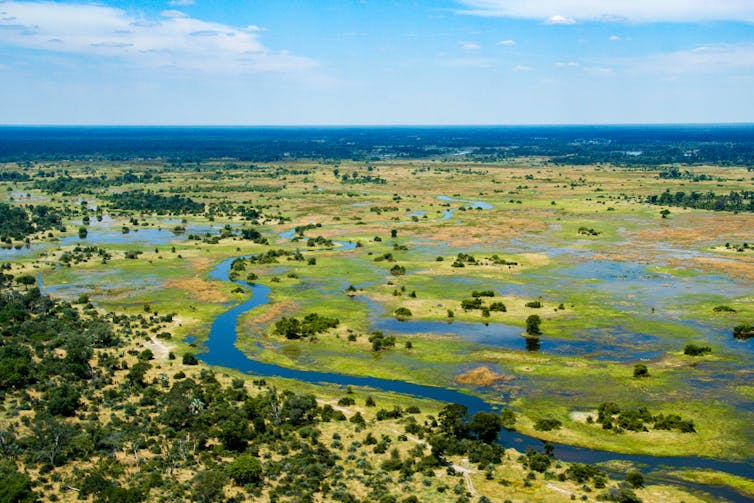Worrying news has recently come to light: hundreds of elephants have been found dead in Botswana, and as yet, there is no clear cause of death. But as an expert in elephants and their conservation, I believe we can at least rule out a few possible answers.
Here’s what we do know: the first deaths were reported in March, but significant numbers were only recorded from May onwards. To date, it’s thought that the death toll stands at nearly 400 elephants of both sexes and all ages. Most of the deaths have occurred near the village of Seronga on the northern fringes of the Okavango Delta, a vast swampy inland region that hosts huge wildlife populations. Many of the carcasses have been found near to water.
Of those discovered so far, some lay on their knees and faces (rather than on their side), suggesting sudden death, although there are also reports of elephants looking disoriented and even walking in circles. The tusks of the dead elephants are still in place and, as yet, no other species have died under similar circumstances.

Botswana’s elephant politics
Botswana has long been a stronghold for Africa’s remaining 400,000 elephants, boasting a third of the continent’s population. While elephant numbers have widely declined in recent decades, largely due to poaching, Botswana’s population has grown.
However, this growth has been outpaced by the ever-increasing human population. With more elephants and more people, competition for space has escalated and increasingly, elephants and people find themselves at odds. Some communities see elephants as pests, as they feed on and trample crops, cause damage to infrastructure and threaten the lives of people and livestock. In return, people retaliate by killing and injuring offending elephants.
With large rural communities struggling to coexist with elephants, the issue has become highly politicised. In 2019, in a controversial move, president Mokgweetsi Masisi lifted a ban on the hunting of elephants in Botswana, reasoning that hunting could both reduce their numbers and generate income for struggling rural communities. This, against a backdrop of rising poaching, suggests that times are changing for Botswana’s elephants.

Speculation
This has sparked speculation about the recent deaths. However, given what we know, we can address some of the rumours.
Firstly, it seems unlikely that poachers are to blame, since the tusks of the dead elephants have not been removed. It’s estimated that illegal black-market ivory trade is responsible for the deaths of 20,000 elephants annually.
The elephants could have been killed by frustrated local people, typically by shooting or spearing. In this case however, the sheer number of dead elephants and the lack of reports of gunshot or spearing wounds, does not support this hypothesis.
Poisoning could be used instead, either by poachers or in retaliation by locals. A few years ago hundreds of elephants in Zimbabwe died after drinking from watering holes laced with cyanide, and the proximity of many of the recent deaths to water has given the idea some foundation.
However, in the event of poisoning, we would expect to see other species dying as well, either because they drank from the same poisoned water source or because they fed on the poisoned carcass of the elephant, and this has not been reported.
A natural cause of death?
If the evidence currently available doesn’t support foul play, that leads us to consider natural causes.
Drought can cause significant deaths. In 2009, a drought killed around 400 elephants in Amboseli, Kenya, a quarter of the local population. But drought tends to kill the very young and old, while the deaths recently reported in Botswana show elephants of all ages are affected. Moreover, rainfall in recent months has been near normal, ruling out the influence of drought.

Perhaps because wildlife disease has gained much attention in light of the COVID-19 pandemic, the remaining possibility that has been widely suggested is disease. While COVID-19 itself is unlikely, elephants, like humans, are affected by a range of diseases.
For instance, over 100 were suspected to have died from an anthrax outbreak in Botswana in 2019. Those elephants that seemed disoriented and to be walking in circles might suggest a disease causing a neurological condition.
Still, the information currently available is inconclusive. The Botswana government has released a statement explaining that investigations are ongoing and that laboratories had been identified to process samples taken from the carcasses of dead elephants.
To avoid further speculation and prevent the deaths of more elephants in their last remaining stronghold, it’s vital that investigations are expedited so that the cause of death can be determined and suitable action taken.




